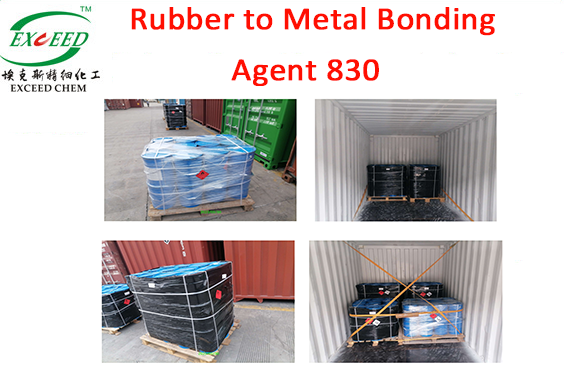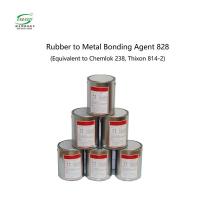Bonding Rubber To Metal Adhesive Comparable to Chemlok 250 6150 Cilbond 89E
1. Introduction(What Is Bonding Rubber To Metal Adhesive 830)
Bonding Rubber to Metal Adhesive 830 is a versatile, one-coat
adhesive designed for bonding a wide range of elastomers to various
substrates during vulcanization. Its formulation consists of a
blend of polymers, organic compounds, and mineral fillers dissolved
or dispersed in an organic solvent system. This single-coat
application simplifies the bonding process, reducing labor, solvent
usage, inventory, and shipping costs.
Adhesive 830 effectively bonds natural rubber (NR), polyisoprene
(IR), styrene-butadiene (SBR), polybutadiene (BR), polychloroprene
(CR), nitrile (NBR), butyl (IIR), EPDM, and polyepichlorohydrin
(ECO) elastomers to a variety of metals, including carbon and alloy
steels, stainless steel, aluminum, copper and copper alloys,
magnesium, and zinc. It also adheres well to certain plastics,
composites, and fabrics.
Equivalent to Chemlok 250/6150, Cilbond 89E, Thixon 2001.
2. Features and Benefits
- Convenient: Single-coat application reduces labor, solvent use, inventory, and
shipping expenses.
- Versatile: Bonds a broad spectrum of elastomers to metals, plastics, and
fabrics. Compatible with existing production lines and tolerates
diverse stock formulations.
- Durable: Achieves rubber-tearing bonds and provides excellent adhesion to
plated metals, minimizing scrap rates.
3. Physical Properties
| Appearance | Black Liquid |
| Viscosity, cps @ 25°C (77°F) Brookfield LVT Spindle 2, 30 rpm | 150-500 |
| Density(kg/m3) | 935.5 – 985.5 |
| Solids Content by Weight, % | 24-26 |
| Flash Point (Seta), °C | 30 |
| Solvents | Xylene, Trichloroethylene |
4. Applying Bonding Rubber To Metal Adhesive 830
1). Chemical Cleaning
Suitable for automated lines and parts susceptible to distortion
from blast cleaning or requiring tight tolerances. Phosphatizing is
commonly used for steel, while conversion coatings are typical for
aluminum.
2). Mechanical Cleaning
Grit blasting is the most common method. Use steel grit for ferrous
metals and aluminum oxide, sand, or other nonferrous grit for
stainless steel, aluminum, brass, zinc, and other nonferrous
metals. Machining, grinding, or wire brushing can also be used.
For detailed surface preparation instructions for specific
substrates, consult the Adhesives Application Guide. Handle cleaned
metal surfaces with clean gloves to prevent contamination. Apply
Adhesive 830 to stainless steel, aluminum, brass, and other
nonferrous substrates within one-half hour of cleaning. Ferrous
substrates like steel can tolerate longer layover times if rust
formation is prevented.
Mixing – Thoroughly stir Adhesive 830 before use and maintain agitation
during use to ensure uniform suspension of solids. Dilution, if
necessary, should be determined empirically based on the
application method. Agitation is crucial as dilution accelerates
settling.
Applying – Apply 830 adhesive by brush, dip, roll coat, spray or any other
method that gives a uniform coating and avoids excessive runs and
tears. When using 830 adhesive as a one-coat adhesive, the dry fi
lm thickness should be 17.8-30.5 micron (0.7-1.2 mil). When used as
a covercoat over a primer, the dry film thickness of 830 adhesive
should be 15.2-20.3 micron (0.6-0.8 mil).
• Brushing
Apply full strength. The best bonds will be achieved by a uniform
and complete surface coverage.
• Dipping
Dilute adhesive with 10-25% xylene or toluene, by volume, to a Zahn
Cup #2 viscosity of 30-48 seconds. Controlled withdrawal minimizes
tears and drips.
• Roll Coating
Apply full strength. For best results, apply uniformly to surfaces.
• Spraying
Dilute adhesive 830 with 25-50% xylene or toluene, by volume, to a
Zahn Cup #2 viscosity of 21-24 seconds. The adhesive must be wet
when it reaches the metal part. If drying occurs in the air before
reaching the metal, cobwebbing and poor adhesion will result.
For electrostatic applications, dilute adhesive to a Zahn Cup #2
viscosity of 30 seconds, using technical grade methyl ethyl ketone
(MEK) in ratio of 4 parts adhesive to 1 part solvent.
Drying/Curing – Allow the applied adhesive to dry for 20-40 minutes at room
temperature until the solvent has completely evaporated. Drying
time can be reduced by preheating metal inserts (maximum
65°C/150°F) or oven drying after application. Moderate drying
temperatures are recommended for coated parts, although
temperatures up to 149°C (300°F) can be used for short periods.
Maximum airflow at minimum temperatures optimizes drying.
Dried adhesive films are non-tacky, allowing coated parts to be
stacked for later processing. Handle coated parts with clean gloves
and protect them from contamination. Properly protected coated
parts can withstand extended layover times before bonding, although
high humidity may shorten this window. Damaged areas can be
recoated before bonding.
Adhesive 830 is suitable for compression, transfer, injection, and
other molding processes. Optimal adhesion occurs when the rubber is
fully cured concurrently with the adhesive. Load the coated metal
parts into the mold and quickly fill the cavity with rubber.
Dry adhesive films remain stable at molding temperatures,
minimizing wiping or sweeping during transfer and injection
molding. While minimizing mold loading cycles is preferred,
Adhesive 830 can withstand moderate prebaking times. Transfer and
injection molds require well-designed runners and sprues, along
with sufficient pressure, to prevent premature rubber curing.
Cleanup – Use solvents such as xylene and MEK to remove adhesive before
heat is applied. Once cured, removal by solvent is not possible.
5. Shelf Life/Storage
Shelf life is one year from date of shipment when stored in a well
ventilated area at 21-27°C (70-80°F) in original, unopened
container. Do not store or use near heat, sparks or open flame.
Avoid excessive exposure to high humidity. Keep container tightly
closed when not in use. Once opened, fit the 55-gallon drum of
adhesive with desiccant tubes.
6.Packing
3.5kg/drum; 20kg/drum










